Welcome to our blog on high-density orange plantations! You’ve come to the right place if you’re interested in maximizing your orange yield and optimizing your space. This article explores everything you need about high-density orange plantations, including spacing, plants per acre, techniques, cost, and yield.
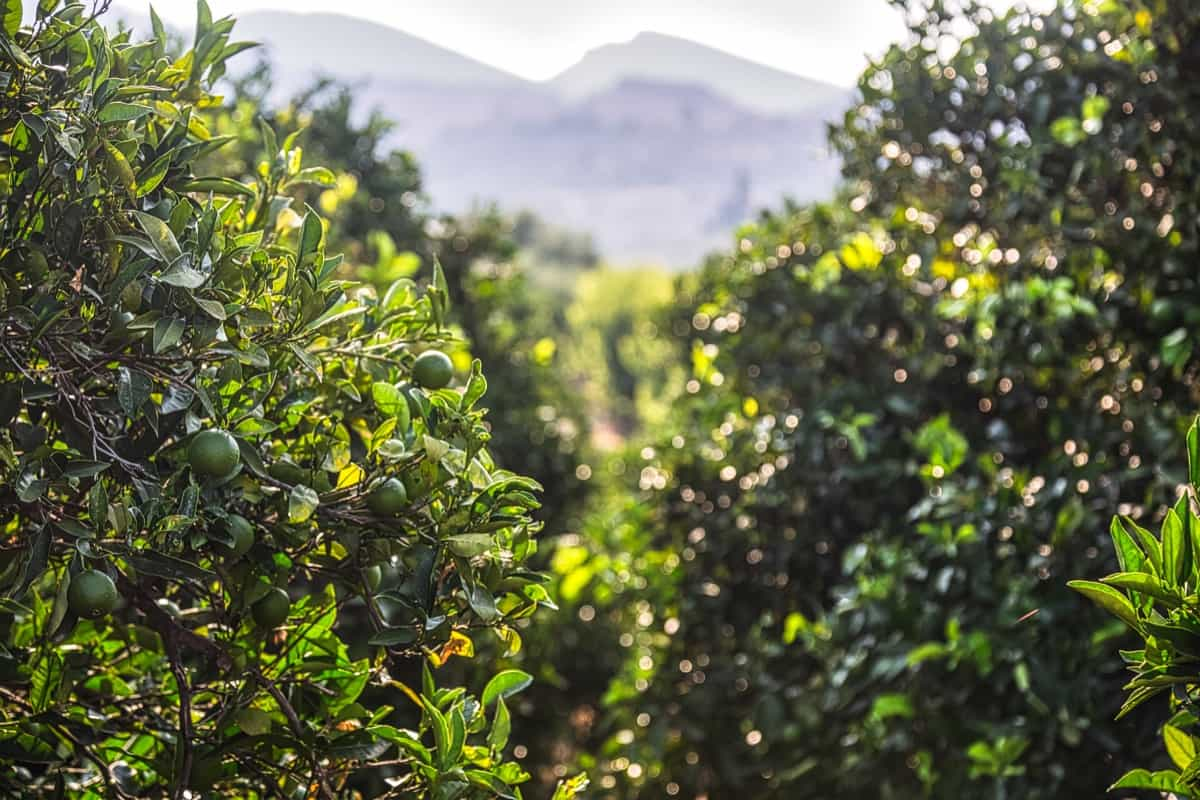
We’ll provide accurate data to help you make informed decisions. So, whether you’re a seasoned orange grower or starting, this engaging and easy-to-read guide will equip you with the knowledge you need to succeed. Let’s dive in and discover the world of high-density orange plantations.
What is High-Density Orange Plantation?
The high-density orange plantation is a modern farming technique that maximizes orange production in a limited space. By utilizing efficient spacing and planting techniques, farmers can significantly increase the number of orange trees per acre compared to traditional methods. This approach involves planting trees closer together, typically at a spacing of 6 to 10 feet.
Farmers can achieve higher yields per acre with this closer proximity while optimizing land utilization. By implementing high-density orange plantations, growers can potentially have 300 to 500 trees per acre, depending on the specific variety and regional conditions. This technique offers a promising solution for maximizing orange production sustainably and efficiently.
Maximizing Profits in High-Density Orange Plantation
High-density planting (HDP) technology in citrus fruit cultivation offers numerous benefits compared to traditional planting systems. Citrus fruits like sweet orange, grapefruit, lime, lemon, and mandarin are commonly grown, but limited land availability and traditional practices hinder production and productivity in developing countries. HDP involves pruning practices, planting distances, dwarf rootstocks, and plant growth regulators.
Successful HDP implementation requires annual pruning following recommended techniques, the utilization of dwarf rootstocks such as trifoliate, Troyer citrange, and Assam lemon, appropriate planting distances, and the application of plant growth regulators like Paclobutrazol and GA3, along with proper nutrient management. HDP provides advantages such as early production, increased profitability, efficient land, water, and nutrient use, improved pest control, and easier weed management.
High-density planting has been successfully employed in various fruits, including apples, pears, citrus, banana, and pineapple. It necessitates economically viable practices and the selection of suitable varieties and rootstocks. Adequate light penetration is crucial in HDP as it influences photosynthesis, flowering, fruit set, and quality. Rootstock selection impacts tree size, quality, and fruit yield. Pruning techniques depend on variety, age, vigor, and fruiting habits.
In case you missed it: How this Farmer Earning 8 Lakhs from 3 Acres Sweet Orange Cultivation – A Success Story of a Mosambi/Sweet Lemon Farmer
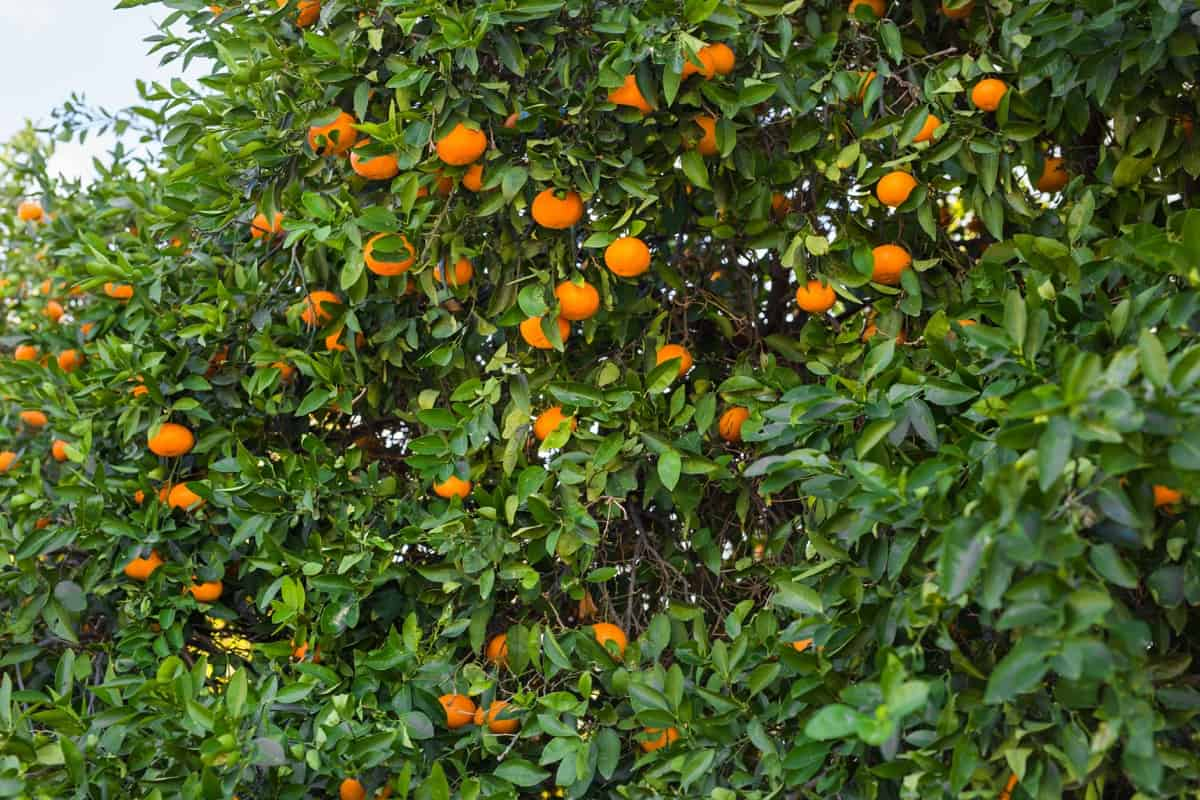
Optimal spacing is essential to maximize production while considering yield and fruit quality. Sufficient space should be allocated to allow proper light penetration, and pruning should aim to achieve the highest possible fruit-bearing volume per unit area. HDP technology brings economic advantages by enhancing fruit quality, reducing production costs, promoting early precocity, and minimizing spray drift.
Benefits of High-Density Orange Plantation
- High-density orange plantation offers numerous benefits that can revolutionize fruit growing. By implementing this modern technique, farmers can achieve higher early yields with superior fruit quality by planting more nursery trees per unit area.
- This approach maximizes returns per unit of inputs by efficiently utilizing natural resources and optimizing vertical and horizontal space. It balances vegetative growth and fruiting, focusing on growing fruit rather than trees.
- The high-density orange plantation is especially valuable in the face of limited arable land due to urbanization and rising energy and land costs. It accommodates more plants per unit area, reducing the gestation period and increasing productivity.
- With dwarfing rootstocks and pruning techniques, energy is directed towards economic parts, resulting in higher production per unit area. This eco-friendly system optimizes light, water, and nutrient usage while reducing the long-term cost of production.
- High-density orange plantations can be categorized into low, medium, high, ultra-high, super-high, and meadow orchards, each with its own planting density, training, and pruning requirements.
- Compared to traditional planting systems, high-density planting offers early precocity, higher productivity, easier management, lower labor requirements, lower production costs, easier harvesting, and improved fruit quality.
- While establishment costs may be higher, the potential for increased yields and profitability makes it a scientifically sound investment for fruit growers.
High-Density Orange Plantation Techniques
High-density orange plantation techniques involve maximizing the number of orange trees in a given area to increase productivity. These techniques focus on pruning, planting distances, and using dwarf rootstocks and plant growth regulators. Pruning should be done annually using recommended methods, and dwarf rootstocks like trifoliate and citrange are utilized.
Appropriate planting distances ensure efficient land utilization while plant growth regulators manage growth and development. High-density planting leads to earlier production, higher returns, improved nutrient and water usage, efficient pest control, and easier weed management.
High-Density Orange Plantation Varieties
High-density orange plantations encompass a range of suitable varieties for this planting system. Citrus varieties commonly used in high-density orange plantations include Valencia, Hamlin, Navel, and Pineapple orange. These varieties are selected based on their adaptability to high-density conditions, yield potential, fruit quality attributes, and market demand.
In case you missed it: How to Control Pests and Diseases in Oranges: Causes, Symptoms, Chemical, and Biological Management
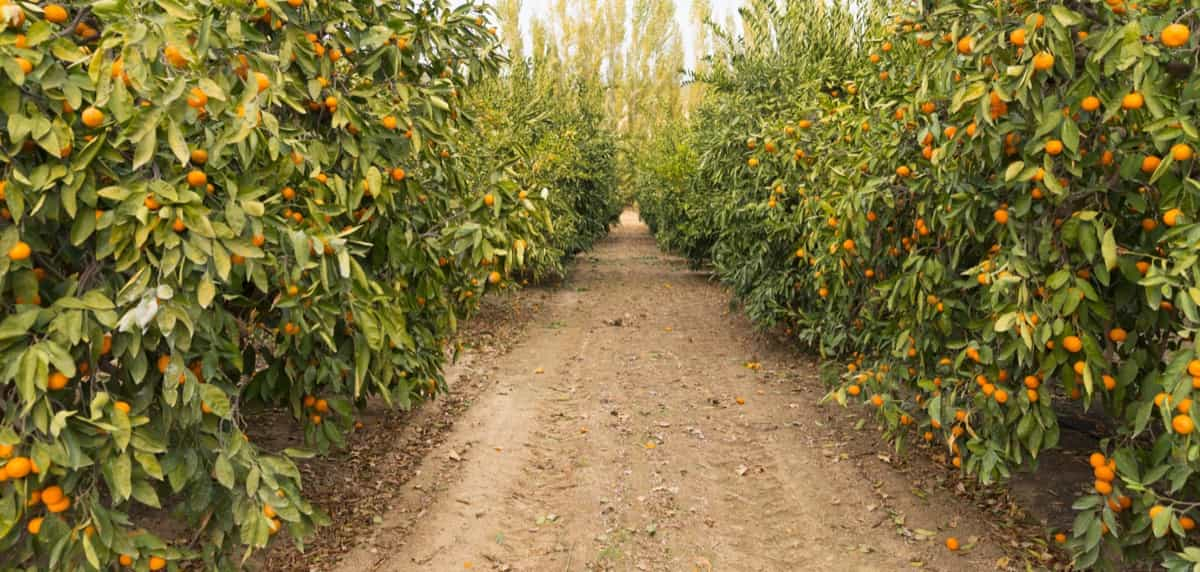
Valencia oranges are known for their excellent juice quality and late-season availability. Hamlin oranges are early-maturing with good juice content. Navel oranges have seedless fruit and are popular for fresh consumption. Pineapple oranges offer a unique flavor profile.
Increasing Yield in High-Density Orange Plantation
Increasing yield in high-density orange plantations requires implementing various strategies and practices. One effective approach is to optimize tree spacing, ensuring adequate light penetration and airflow. This can be achieved by maintaining a planting distance of 3-4 meters between trees.
Regular pruning is crucial for removing diseased or overcrowded branches, promoting better light exposure and air circulation within the canopy. Selecting appropriate rootstocks, such as trifoliate or troyer citrange, can enhance tree vigor and yield. Proper nutrient management, irrigation techniques, and pest control measures maximize yield.
Sustainable and Best Practices for High-Density Orange Plantation
Soil: Optimal soil for sweet orange farming is loamy, well-drained soil with a steady texture up to 2-3 meters deep. The soil’s pH level should be between 6.5-7.5 to maximize yield.
Climate: Sweet oranges thrive in tropical to semi-tropical climates with a yearly rainfall of 600-700 mm. The 30-40 degrees Celsius range is ideal for achieving the best results.
Planting Material: It is crucial to use healthy, virus-free budded plants obtained from reputable nurseries and research centers for planting.
Preparation of Lands: Agricultural land should be plowed and tilled to a fine texture. Dig pits measuring 1 square meter for planting seedlings, and mix the topsoil with organic matter such as farmyard manure (15-20 kg), superphosphate (500-600 grams), and Methyl Parathion (30 grams) to provide essential nutrients and protect against fungal infestation.
Planting Time and Spacing: The ideal planting period is from July to December. Ensure that the bud joint is kept above the soil level during planting. Regularly water the seedlings and provide support with stakes to protect against wind damage. Maintain a spacing of 6 meters by 6 meters between each plant.
Manures and Fertilizers: Apply manures and fertilizers per plant based on the growth stage. Nitrogen, phosphorus, and potassium doses increase gradually each year. Deep watering devices can apply fertilizers at a depth of 25 cm, ensuring uniform distribution of nutrients.
Irrigation: After planting, shallow irrigation should be done every ten days, avoiding overwatering. As the roots grow deeper, transition to deep irrigation to supply water directly to the roots. Take care to water the plants adequately during flowering and fruiting stages.
Pruning and Training: Regular pruning helps maintain plant vigor. Remove dropping branches and diseased or damaged parts periodically. Prune shoots grow up to 50 cm from the ground. Keep the center stem open with uniformly distributed branches. Bordeaux paste (1%) can be applied for better results.
In case you missed it: How to Grow Oranges in USA: Check How this Guide Helps Beginners in Orange Farming
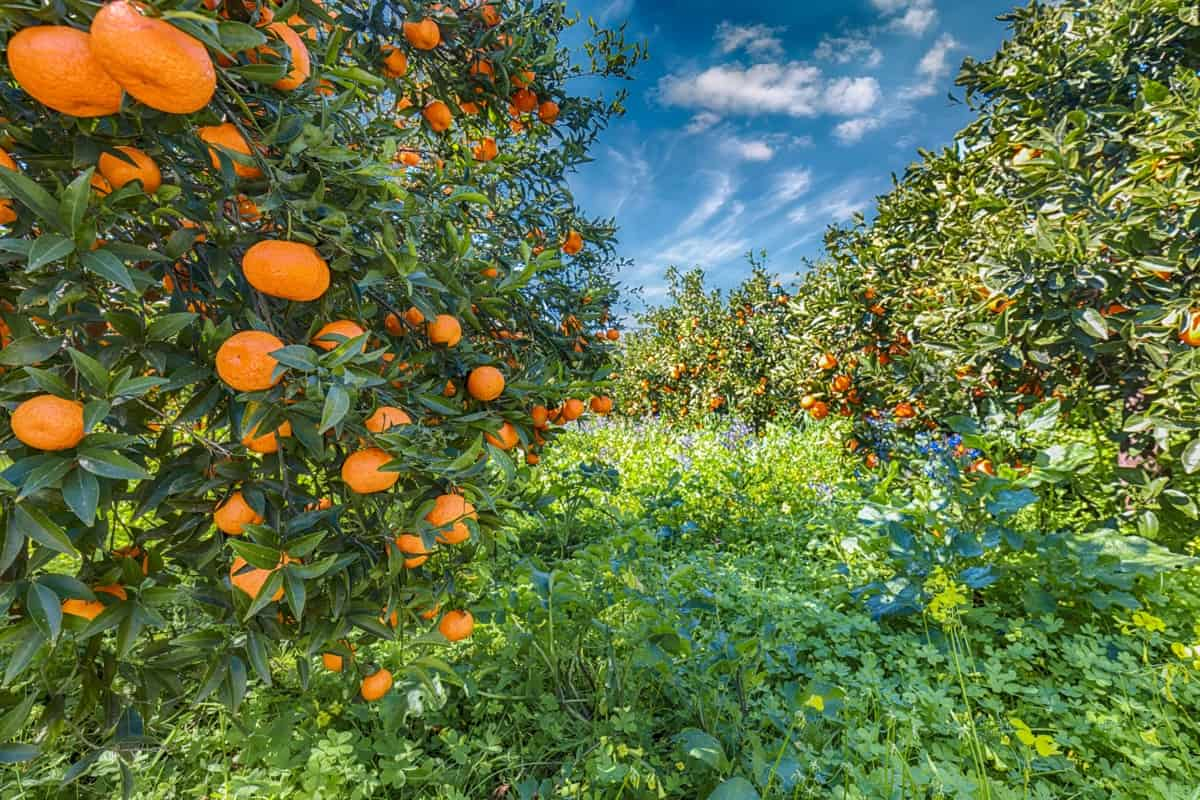
Intercrops: Intercropping can be beneficial, especially during the pre-bearing phase of sweet oranges. Consider growing short-term leguminous crops and cucurbitaceous crops.
Bahar Treatment: Bahar treatment is widely practiced to induce timely blooming, fruiting, and harvesting. It involves manipulating watering cycles, land management, and additional fertigation. This treatment helps synchronize the three distinct seasons of flushes for sweet oranges.
Pest Control: Various pests can affect orange plants. Effective control measures include using appropriate sprays for leaf miners, citrus butterflies, bark and stem borers, rust mites, fruit-sucking moths, aphids, and powdery mildew. Regular monitoring and prompt action are essential.
Harvesting: Sweet oranges typically bear fruit after the 4th year. Applying a spray of potassium nitrate one month before harvesting can improve fruit size, rind smoothness, and juice content. Harvesting occurs in different seasons depending on the region, with an average yield of 16-20 tons per acre.
High-Density Orange Plantation Spacing
The spacing of citrus trees in high-density orange plantations has been a topic of discussion to maximize profits. In Japan, dwarf citrus cultivars are planted with a spacing of 9 feet x 9 feet (2.74 m x 2.74 m), known as high-density planting. The traditional planting density in California is 20 feet x 22 feet (6.10 m x 6.71 m).
With suitable rootstocks, it is possible to grow 800 plants per acre (4046.856 m²) successfully. Under normal conditions, 140-300 trees are planted per acre. Studies have shown that planting kinnow citrus at a spacing of 1.8×1.8 m (3000 plants/hectare) can yield 20 tons/hectare, 200% more than traditional.
The choice of rootstock also plays a significant role, with dwarf rootstocks like Troyer citrange and Fly Dragon Trifoliate Orange suitable for high-density planting due to their small size and early production. These rootstocks offer advantages such as disease resistance, good fruit quality, and tolerance to environmental stresses. New dwarf rootstocks and specific spacing can lead to higher, more consistent yields, improved fruit quality, and reduced harvesting costs.
Optimal Fertilization for High-Density Orange Plantation
Using growth regulators in high-density orange plantations can help manage vegetative growth, delay flowering, and reduce fruit drop. However, due to poor penetration, applying foliar sprays to tall trees with dense canopies is ineffective. Growth retardants like ECC, Ancymidal, Paclobutrazol, and B-9 can control vegetative growth in fruit trees.
Malnutrition, moisture stress, insect pests, and hormonal imbalance can cause fruit drops in citrus trees. Decreased auxin and increased ABA concentrations contribute to fruit drop. Applying auxin and gibberellins can control fruit drop and improve fruit quality. Paclobutrazol application improves flowering but reduces new shoot growth. Recommended fertilization rates per plant include:
- FYM (20 kg in the first year, with a yearly increase of 5 kg).
- Nitrogen (100 g with a yearly increase of 100 g).
- Phosphorus (50 g with a yearly increase of 50 g).
- Potassium (25 g with a yearly increase of 25 g).
In case you missed it: Top 19 Steps/Ways to Boost Orange Yield: How to Increase Fruit Production, Size, and Quality
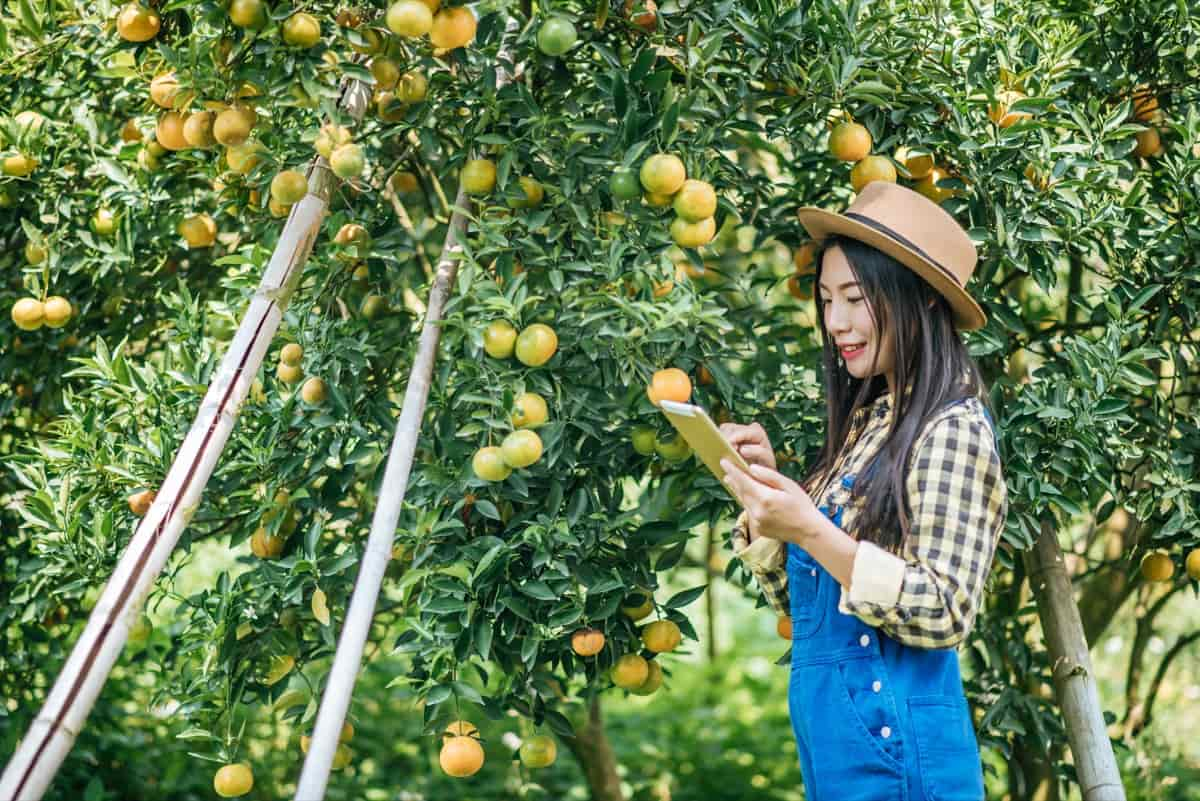
Fertilizers should be applied in a circular belt around the tree base, maintaining a distance of 120 cm, and deep watering devices can help ensure uniform nutrient distribution. To prevent mineral deficiencies, spraying solutions of various minerals should be considered, and additional nutrients like zinc, manganese, and iron can be applied annually per plant.
Specific growth regulators like 2-Chloroethyl Phosphonic acid, Alar, and Cycocel can induce flower formation in Valencia orange. At the same time, the supply of CCC through root irrigation in lemon trees can promote early flowering and improved fruit sets.
High-Density Orange Plantation Pruning Methods
Pruning plays a crucial role in high-density orange plantations. Slow-growing citrus species respond well to pruning, making it easier to maintain the size of the trees. Pruning helps adjust the tree shape, balance the ratio between framework and bearing canopy, alter the top/root ratio, and affect the carbohydrate status of the plant. Light pruning of 25 cm from the terminal portion of lemon shoots has been found to yield better results compared to less pruning or no pruning.
Techniques such as topping, hedging, increasing tree density, and using dwarf rootstocks are commonly used to control the size of citrus trees. Reduction of 10% tree canopy in crowded orchards leads to a significant increase in annual yield. Standard pruning equipment includes secateurs, loppers, and pruning saws, which should be sterilized using a 3% sodium hypochlorite solution. Pruning should be done after severe winter but before the onset of summer to stimulate optimal growth.
Protection of exposed parts with paint is recommended to prevent sunburn. Different pruning techniques include suckering (removing thorny rootstock), removing gourmands (water sprouts), skirting up to avoid fruit touching the ground, canopy thinning for light penetration, and reducing tree height. Canopy thinning enhances fruit quality by allowing better light penetration. Pruning also helps manage citrus pests and promotes balanced bearing. Maintaining smaller trees in high-density plantings improves light capture, fruit conversion, and orchard aeration.
Managing Pests and Diseases in High-Density Orange Plantations
- Leaf Miner: Spray azadirachtin 1% (10 ml/liter) after new foliage emergence, followed by a second spray with NSKE 5% + dichlorovos 0.5 ml or imidacloprid/100 SL 0.5 ml after a week.
- Citrus Butterfly: To control infestation, spray seedlings with Bacillus thuringiensis 1g, Rynaxypyr 0.2 ml, or flubendiamide 0.1 ml/liter water.
- Bark and Stem Borer: Fill caterpillar-bored holes with fuel, kerosene, or malathion (5-8 ml) and seal them with clay to kill larvae.
- Rust Mites: To avoid juice-sucking bugs and discoloration, use soaking sulfur (3 g), dicofol 2 ml, or ethion 2 ml per liter of water during fruiting or on the fruits.
- Fruit Sucking Moths: Discard infested and dropped fruits since they attract adult moths. Spray one liter of water with 0.5% neem oil and 0.5 ml sandovit or teepol. Avoid late harvesting.
- Aphids on soft shoots, spray imidacloprid 0.5 ml or dimethoate 2 ml per liter of water. After ten days, spray neem oil 0.5% or NSKE 5% again.
- Powdery Mildew: Spray Karathane 0.1% or wettable sulfur 0.2% on the leaf surface twice a fortnight to eliminate powdery fungal growth.
High-Density Orange Plantation Harvesting Tips
- Oranges bear fruit after 2-4 years. Applying a spray of potassium nitrate (5-10 grams/liter water) one month before harvesting can enhance fruit size, smoothness of rinds, and increase juice content.
- Two cropping sessions are undertaken annually in India due to favorable climatic conditions. Harvesting is typically done in August-September and again in March-May.
- The expected average yield in high-density orange plantations is approximately 16-20 tons per acre.
In case you missed it: High Density Almond Plantation: Spacing, Plants Per Acre, Techniques, Cost, and Yield

High-Density Orange Plantation Cost Analysis (1 Acre Basis)
Production Cost
- This includes pre-planting expenses, such as land preparation and tree planting, and ongoing costs, like irrigation, fertilization, and pest control.
- The total cost of establishing a high-density orange plantation is estimated at $13,722 per acre.
- This includes expenses for land preparation, irrigation system installation, tree planting, materials, labor, and equipment.
Returns
- The average orange yield per acre is projected to be 42.5 tons.
- The estimated price per ton of oranges is $481.50, resulting in total revenue of $20,487.50 per acre.
Profits
After deducting the production costs from the revenue, the net return is $6,765.50 per acre. The net return accounts for overhead costs, such as taxes, insurance, and management expenses.
Note: It is important to note that these figures may vary depending on specific regional factors, such as labor wages, input prices, and local market conditions.
Conclusion
High-density orange plantations, optimal spacing is crucial, with recommended plants per acre ranging from 600 to 8,000. Utilizing modern techniques, such as drip irrigation and pruning, can enhance yield. Initial costs for setup are higher but can be offset by increased yield and quality.
- Types of Pesticides Used in Agriculture: A Beginner’s Guide
- Economical Aquaculture: A Guide to Low-Budget Fish Farming
- 15 Common Planting Errors That Can Doom Your Fruit Trees
- How to Make Houseplants Bushy: Effective Tips and Ideas
- Innovative Strategies for Boosting Coconut Pollination and Yield
- Pollination Strategies for Maximum Pumpkin Yield
- The Complete Guide to Chicken Fattening: Strategies for Maximum Growth
- Natural Solutions for Tulip Problems: 100% Effective Remedies for Leaf and Bulb-Related Issues
- Revolutionizing Citrus Preservation: Towards a Healthier, Greener Future
- Natural Solutions for Peony Leaf and Flower Problems: 100% Effective Remedies
- Maximizing Profits with Avocado Contract Farming in India: A Comprehensive Guide
- Natural Solutions for Hydrangea Problems: 100% Effective Remedies for Leaf and Flowers
- The Ultimate Guide to Choosing the Perfect Foliage Friend: Bringing Life Indoors
- From Sunlight to Sustainability: 15 Ways to Use Solar Technology in Agriculture
- The Ultimate Guide to Dong Tao Chicken: Exploring from History to Raising
- The Eco-Friendly Makeover: How to Convert Your Unused Swimming Pool into a Fish Pond
- Mastering the Art of Delaware Chicken Farming: Essentials for Healthy Backyard Flocks
- 20 Best Homemade Fertilizers for Money Plant: DIY Recipes and Application Methods
- How to Craft a Comprehensive Free-Range Chicken Farming Business Plan
- Brighten Your Flock: Raising Easter Egger Chickens for Beauty and Bounty
- How to Optimize Your Poultry Egg Farm Business Plan with These Strategies
- Subsidy for Spirulina Cultivation: How Indian Government Schemes Encouraging Spirulina Farmers
- Ultimate Guide to Raising Dominique Chickens: Breeding, Feeding, Egg-Production, and Care
- Mastering the Art of Raising Jersey Giant Chickens: Care, Feeding, and More
- Ultimate Guide to Raising Legbar Chickens: Breeding, Farming Practices, Diet, Egg-Production
- How to Raise Welsummer Chickens: A Comprehensive Guide for Beginners
- How to Protect Indoor Plants in Winter: A Comprehensive Guide
- Ultimate Guide to Grow Bag Gardening: Tips, Tricks, and Planting Ideas for Urban Gardeners
- Guide to Lotus Cultivation: How to Propagate, Plant, Grow, Care, Cost, and Profit
- Agriculture Drone Subsidy Scheme: Government Kisan Subsidy, License, and How to Apply Online
- Ultimate Guide to Raising Araucana Chickens: Breed Profile, Farming Economics, Diet, and Care
- Bringing Hydroponics to Classroom: Importance, Benefits of Learning for School Students
- Ultimate Guide to Raising Polish Chickens: Breed Profile, Farming Economics, Diet, and Care
- Ultimate Guide to Raising Australorp Chickens: Profile, Farming Economics, Egg Production, Diet, and Care
- Silkie Chicken Farming: Raising Practices, Varieties, Egg Production, Diet, and Care
- Sussex Chicken Farming: Raising Practices, Varieties, Egg Production, Diet and Care